This article needs additional citations for verification .(June 2019) |
This article needs additional citations for verification .(June 2019) |
| Festival name | Date - Hindu lunar calendar | Date - Gregorian calendar | Deity or object worshipped | Duration | Description | ||
|---|---|---|---|---|---|---|---|
| Ugadi or Samsar Padva | 1st day of Chaitra | March–April | Example | Ugadi or Samsar Padava is the new year day of Hindu lunar calendar (last week of March). Ugadi is derived from the words Yuga Aadi (Yuga + Aadi meaning "Beginning of New era"). According to Bramha Purana, Lord Brahma started creation on this day - Chaitra shuddha padhyami or the Ugadi day. It also commemorate the victory of Rama over Vali, a South Indian King. In temples the New Panchang or almanac is ceremoniously released and the Samvatsara Phala or the predictions for the whole year are read out. New clothes are put on. In some families there is a system of "kappad vadap" which means dedication of saris and dhotis to the memory of the departed souls with an offering of food or sweet beaten rice and an arti. The head of the family does it without the assistance of a priest and after food, the dhoti will be put on by him and sari, his wife. | |||
| Ram Navami and Hanuman Jayanthi | 9th day and full moon day of Chaitra | March–April | Rama, Hanuman | Example | Ram navami and Hanuman jayanti, the birthdays of Shree Ramchandra and Hanuman respectively are also celebrated in the month of Chaitra. | ||
| Wata Pournima | Full moon day of Ashada | July | Husband | Example | Is women's festival where women tie threads around a banyan (wad) tree and pray for the same husband in every birth (after Satyavaan-Saavitri's story). | ||
| Naga Panchami | 5th Day of Shravan | July–August | Nāga | Example | Celebrated on the 5th day of the bright fortnight in the month of Shravan. Milk is offered to naga idols with arti and prayers to nagas. The festival falls during the rainy months and is believed to counter the increased possibility of a snake bite during this time. People visit Naga temples worship them. Shiva temples are also favoured places for veneration as snakes are considered dear to him. In South India, people craft images of snakes using cow dung on either side of the entrance to the house to welcome the snake god. The practice of worshipping the snake on this day is related to many legends. Nag Panchami is believed as the victory day of Krishna over the Kaliya snake. | ||
| Sutta Punav | Full moon day of Shravan | Aug | Yajnopavita or the sacred jannuvey | Example | On this Shravan full moon day, GSB men worship and change the sacred thread. In northern India, this day is celebrated as Raksha bandhan. | ||
| Janmashtami | 23rd day of Shravan | Aug–September | Krishna | Birthday of Lord Krishna on Shravan Vadya ashtami is observed with a fast. | |||
| Ganesh Chaturthi | 4th day of Bhaadrapada | August–September | Ganapati | 1.5 to 10 days | Festival of Lord Ganesh. On the previous day, Gowri Pooja is performed by the women. The Ganesh Puja is performed by men. Mahalaya amavasya | 15 day of Bhaadrapada | pritra tarpan is performing in this day |
| Navaratri | Ashvin | September–October | Parvati(all forms), Lakshmi, Saraswathi | Nine nights, ten days | Navaratri literally means nine nights (Nav = nine ; Ratri = nights). The first 9 days of the Ashwin Shukla Paksha constitute Navaratri with the worship of Mother Goddess. On the first three days, the Mother is invoked as powerful force called Durga in order to destroy all our impurities, vices and defects. The next three days, the Mother is adored as a giver of spiritual wealth, Lakshmi, who is considered to have the power of bestowing on her devotees the inexhaustible wealth. The final set of three days is spent in worshipping the mother as the goddess of wisdom, Saraswati. In West Bengal, Navratri is celebrated as Durga pooja. It lasts for nine days in honour of the nine manifestations of Durga. This commemorates the victory of Goddess Durga over the Asura Mahishasur. The battle between Goddess Durga and the Asura lasted for 9 days and 9 nights. Finally, on the tenth day, Goddess Durga killed Mahisha asura. This day is known as Vijayadasami meaning the 10th day of victory. Idols of Goddess Durga are worshipped for nine days and on the tenth day,the immersion of idols in sea is performed. The nine different manifestations of Durga worshipped over the nine days are - Durga, Bhadrakali, Amba or Jagdamba, Annapurna, Sarvamangala, Bhairavi, Chandika or handi, Lalita and Bhavani. | ||
| Diwali | 1st day of Kartik | October–November | Rama, Krishna, Lakshmi | 4 days | The festival of lights is celebrated over five days. The Deshasthas celebrate this in their unique style by waking up early in the morning and having an oil bath. People light their houses with, lamps, and burst fire crackers over the course of the festival. Special sweets and savouries are prepared for the festival. Colorful Rangoli are made in front of the house. | ||
| Kartik Ekadashi | 11th day of Kartik | Vishnu | Example | This is the 11th day of kartik bright fortnight or the Kartik Ekadashi and is regarded as the day of Lord Hari or Vishnu. This day also coincides with the end of Vishnu's four months sleep, known as Prabodidhiny ekadasi (Awaking Eleventh). Devotees are said to observe fasts and rigorous penances to seek knowledge. All meritorious actions done on this day are said to return with thousandfold credits. Perhaps this has the link with Sun's movement to the southern hemisphere and the Winter. | |||
| Tulsi Pooja | 12th day of Kartik | October–November | Example | Example | This is celebrated on the 12th day of the first half or Shukla Paksha of the month of Kartik to commemorate the marriage of Vishnu and Tulsi. Tulsi is one of the most sacred plants of the Hindus and is believed to be the incarnation of Vrinda, the virtuous wife of Jalandhar. On this day the Tulsi Vrindavan at houses is smeared with cow dung. Sugarcane is buried in it, and avale (fruits of the avali tree) and wet chinch (fruits of the tamarind tree) are put on it. | ||
| Vaikunta Chaturdashi | 14th day of Kartik | October–November | Vishnu | Example | This is celebrated on the 14th day of the first fortnight. This day glorifies the relationship between Shiva and Vishnu. This is also the day Vishnu got his Chakra from Shiva. | ||
| Kartik Purnima | 15th day of Kartik | October–November | Shiva | Example | This falls on the 15th of the full moon day of Kartik, alluding to Shiva's destruction of the demon Tripura and signifies the subjugation of evil and fostering goodness. Fireworks and illuminations of houses make the God's celebration of their victory. It is therefore also called the Dev-Didiwali or Diwali of the Gods. | ||
| Vaikunta Ekadashi | 11th day of Pushya | December–January | Vishnu | Example | This is on the 11th day of the first fortnight. It was on this day that during the Sagara Mathana (churning of the ocean), Amrit (nectar) emerged from the ocean and was distributed to the Gods. Fasting is prescribed on all Ekadashis, that is, the 11th day of the lunar fortnight, twice a month. No rice should be taken on Ekadashi days. | ||
| Makara Sankranthi | 13-15 January | Surya | Example | This holy day marks the commencement of the Sun's northern course in the Heavens - the Uttaraayana patha. This turn in the Sun's course takes place at the point of time when it enters the sign of Makara or Capricorn. From this day the day-duration increases and the night decreases. It is the harbinger of more light and sunshine in life and lessening of its darker aspects. | |||
| Maha Shivaratri | End of Magha | February–March | Shiva | Example | Maha Sivaratri is celebrated on the 14th night of the dark half or Krishna Paksha in the month of Magha. This is the night before the new-moon day in February–March. According to 'Shiva Purana' no festival other than Maha Shivaratri observed by devotees gives Shiva so much pleasure and satisfaction. According to a legend, it signifies the day on which Lord Shiva swallowed the deadly poison that emanated from the churning of the ocean of milk, which would have killed the Gods. Not knowing that it would not cause any harm to Him, all the Gods and Goddesses kept vigil throughout the night praying for His life. The prayer that was offered to Him that night is repeated since then on Shiva Ratri. The devotees observe strict religious discipline by abstaining from food for the day and keep themselves awake the whole night. 'Shiva Linga' is worshipped with 'vilwa' leaves throughout the night with chanting of the 'Panchakshyara Mantra' - "Om Namah Shivay" and Shiva's 1,008 names. The next morning, they take their bath and after worshipping Shiva again break their fasts. |
The other festivals unique to GSB's are-

Venkateswara is a form of the Hindu god Vishnu and is the presiding deity of the Venkateswara Temple, located in Tirupati, Andhra Pradesh, India. Venkateswara is also known by various other names.
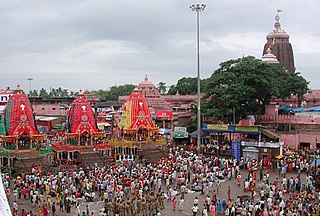
The Ratha Yatraof Puri, also rendered as the Ratha Jatra, is considered the oldest and largest Hindu chariot festival celebrated annually, on the bright half of the lunar month of Ashadh (June–July). The festival is held at the city of Puri, in the state of Odisha, India and associated with the deity Jagannath. During the festival, three deities are drawn by a multitude of devotees in three massive, wooden chariots on bada danda to Gundicha Temple whereby they reside there for a week and then return to the Jagnannath temple. This return trip is referred to as the Bahuda Yatra.

Temple cars or Temple chariots are used to carry representations of Hindu gods around the streets of the temple on festival days. These chariots are generally manually pulled by the devotees of the deity.
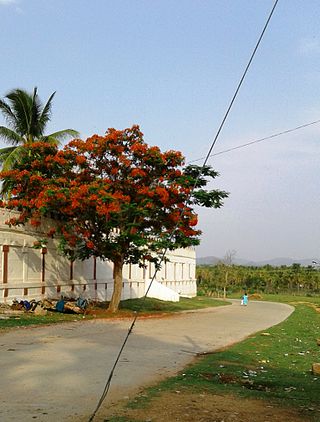
Arsikere is a city and taluka in the Hassan district in the state of Karnataka, India. It is the second largest city in Hassan district, demographically. Arsikere city municipal council consists of 35 wards. This region is known for its coconut production and is also called Kalpataru Nadu. Arsikere Junction is a major railway junction in the South Western Railway which links Mangalore and Mysore to North Karnataka and a central place for tourists who visit nearby places that do not have rail access, such as Belur, Halebidu and Shravanabelagola, Harnahalli, and Kodimata.

Matsyendranātha, also known as Matsyendra, Macchindranāth, Mīnanātha and Minapa was a saint and yogi in a number of Buddhist and Hindu traditions. He is traditionally considered the revivalist of hatha yoga as well as the author of some of its earliest texts. He is also seen as the founder of the natha sampradaya, having received the teachings from Shiva. He is especially associated with Kaula Shaivism. He is also one of the eighty-four mahasiddhas and considered the guru of Gorakshanath, another important figure in early hatha yoga. He is revered by both Hindus and Buddhists and is sometimes regarded as an incarnation of Avalokiteśvara.
Basrur / Basroor is a village in Kundapura taluk in Udupi district of Karnataka. Historically Basrur was also called Barcelor, Barcelore, Barcalor, Basnur, Bares, Abu-Sarur and Barsellor.
Kinnigoli is a major suburb in the outskirts of Mangalore Tehsil. It is located approximately 32 km from Mangalore City, 5 km from Kateel, 8 km from Mulki and 17 km from the Mangalore International Airport. Kinnigoli is a fast developing hamlet.
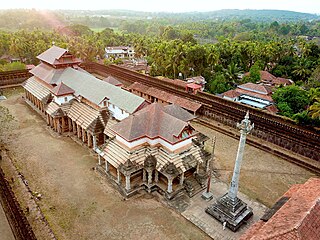
MoodabidriMūḍubidire;, is a town and taluk in Dakshina Kannada district. It lies 34 km northeast of the district headquarters, Mangalore, in Karnataka, India.
Gurupura, Karnataka, India is a small town situated on the Phalguni, or Gurupura River. It is located about 345 kilometres west of Bangalore, the state capital, and 13 kilometres east of Mangalore, Karnataka's chief port city.
Swami Krishnashram was the seventh mathadhipati of the Chitrapur Saraswat Brahmin community from 1839 to 1863.
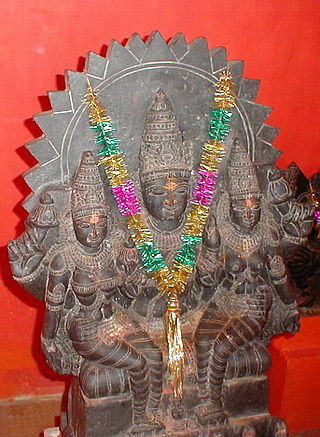
Ratha Saptami or Rathasapthami, also rendered Magha Saptami, is a Hindu festival that falls on the seventh day (saptami) in the bright half of the Hindu month Magha. It is symbolically represented in the form of the sun-god Surya turning his ratha (chariot) drawn by seven horses towards the northern hemisphere, in a north-easternly direction. It also marks the birth of Surya and is hence also celebrated as Surya Jayanti.
Mangalore district that was partitioned from the erstwhile South Canara, has been multicultural and is a little different from the prevalent culture of the Carnataca state of India. A native of Mangalore is known as a Mangalorean in English, Kudladakulu in Tulu, Kodyaalkar in Konknni, Manglurnavaru in Kannada& Maikaaltanga in Byari.

Gundicha Temple, is a Hindu temple, situated in the temple town of Puri in the state of Odisha, India. It is significant for being the destination of the celebrated annual Rath Yatra of Puri. While it remains vacant most of the year, the temple is occupied by images of the deities of Jagannath, his brother Balabhadra and sister Subhadra for seven complete days every year during the annual Rath Yatra festival.

Karkala, also known as Karla in Tulu language, is a town and the headquarters of Karkala taluk in the Udupi district of Karnataka, India. Located about 60 km from Mangalore in the Tulu Nadu region of the state, it lies near the foothills of the Western Ghats. Karkala has a number of natural and historical landmarks, and is a major tourist and transit destination due to its strategic location along the way to Hebri, Sringeri, Kalasa, Horanadu, Udupi, Kollur, Subrahmanya and Dharmasthala.
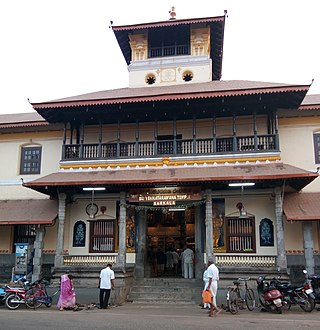
Sri Venkataramana Temple, Karkala, also known as Padutirupathi, is a temple in Karnataka, India. It was built by Goud Saraswat Brahmins of Karkala and was installed on 25 April 1537.

The Mangalore Dasara, is a festival in the Indian city of Mangalore organized by Acharya Mutt. It is also referred as Navarathri Festival, Vijayadashami. The tiger dance, lion dance and bear dance are the main attractions. The city is decorated with lights for the span of 10 days of the occasion.
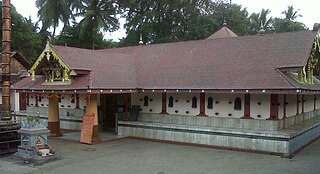
The Sri Lakshmi Narasimha Temple is the foremost temple of Gowda Saraswatha Brahmins in and around Thalassery.

Ratha Yatra, or chariot festival, is any public procession in a chariot. They are held annually during festivals in India, Nepal and Sri Lanka. The term also refers to the popular annual Ratha Yatra of Puri. that involve a public procession with a chariot with deities Jagannath, Balabhadra, Subhadra and Sudarshana Chakra on a ratha, a wooden deula-shaped chariot.